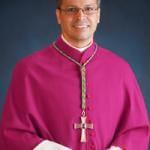Finding a Christian church in Amman is the easiest thing in the world – provided you’re not too picky which church.
Estimates of the numbers of Christians in Jordan range from a high of 390,000, or 6%, to a modest 186,000, or 2.8 %. Beyond dispute, however, is their variety. Jordanian Christians come in all flavors, including Greek Orthodox, Syrian Orthodox, Melkite Greek Catholic, Armenian Apostolic, Maronite Catholic, Latin-Rite Catholic, and Anglican. The churches have synchronized their liturgical calendars in agreement with Orthodox conventions; today they celebrate Easter across the board. Whatever advantages this offers believers themselves, it makes them harder than ever for outsiders to tell apart.
Our little group got its first inkling of this difficulty last night when we piled into our touring vehicles and drove off into the chill spring rain. Our objective was the Easter vigil Mass presided over by Father Nabil Haddad, leader of Amman’s Melkite Greek Catholics. After a few minutes’ tooling up and down West Amman’s one-way streets, we arrived at a cozy limestone church just as the priests were chanting the Exsultet. Though the pews were already too packed for us to sit en famille, the ushers, showing great ingenuity, managed to squeeze us in here and there.
But even through the novelty of hearing the liturgy in Arabic – “Nur mashighi” is “Lumen Christi” – we became gradually aware that something was missing. The bells and smells were all present and accounted for, yet nothing felt very distinctly Melkite. Instead of priests in clanking pectoral crosses and eye-catching hats, we were seeing prim lady lectors fresh from the hairdresser. Up close, it seemed, Oriental mystery had little to distinguish it from the customs of our home parishes.
As we grappled with our sense of deflation, we caught sight of Christine Moore, the tour organizer. She was beckoning us frantically toward the exit, eyes wide with apology. “Let’s go,” she hissed. “I’ll explain later.” After we squeezed back out into the courtyard, to the visible irritation of some congregants, she told us: “That was the wrong church.”
Our intuition had been dead on. Ss. Peter and Paul, the Melkite church where we were expected, was a few hundred yards down the hill. We’d crashed the gate at St.Peter’s, a Latin Rite church that would not have looked too far out of place in an American diocese, occasional glottal stops and aspirated h’s notwithstanding.
This morning, word went around that we’d be attending a Chaldean Mass with Iraqi refugees. When Ra’ed, our tour guide, arrived, he corrected us. The Mass and the refugees would be Assyrian. A Christian himself, Ra’ed gives the impression of appreciating these distinctions. But once our car climbed into the hills of East Amman, we realized we needed the cultural equivalent of a Mississippi river pilot. Riding our brakes down a street no wider than an alleyway, we saw a steeple and a cross peeking out from behind a wall, but Ra’ed rolled his eyes. “That’s Armenian,” he said.
Never shy about asking for directions, he flagged down one group of locals after another, asking, “Al-kilisi as-Surii?” – “The Syrian church?” From their pointing fingers, it was clear that all the men had an opinion – and just as clear that it wasn’t the same opinion. “A few years ago,” Ra’ed said, “the government re-named all the streets in East Amman. These guys are giving directions with the old street names.”
Amman, like Rome and Istanbul, is known as a city of seven hills. The eastern or older part rises straight from the highest of these hills. Many of the buildings are steep and rickety, reflecting the sudden, pressing need to house the hundreds of thousands of Palestinians who fled to Jordan following the 1948 war with Israel.
“I’d hate to think what an earthquake could do to that neighborhood,” Ra’ed said.
But however poor its people, however slapdash its construction, East Amman is one of those places that can’t help being picturesque. The cramped streets wind steeply — and, apparently, endlessly — down to the boulevards at the bottom. Everywhere, olive, palm, and eucalyptus trees creep out from the pavement. All it would take is a general rent hike to turn the area into Laurel Canyon.
Our driver stopped about 30 yards in front of a shabby compound. A sign in English read: “ST. ELIAS’ SYRIAN ORTHODOX CHURCH.”
“Wait up,” I said to Ra’ed. “Is Syrian the same as Assyrian? And anyway, are we looking for Orthodox or Catholic?” Ra’ed, who had bounced out of the shotgun seat like a jack-in-the-box as soon as the parking brake went on, threw back a look which I read to mean: “Don’t be a smartass.”
We watched through the windows as he disappeared through the gate. A minute later, he unlocked the doors and led us through the gate, across the cracked pavement of the silent courtyard and around to the back, where we met a dazed-looking man in a red warm-up jacket.
“This,” Ra’ed told us, “is Zaid. Zaid is a Christian from Iraq. Zaid, these are American guests.”
“Welcome,” said Zaid in English, smiling nervously.
Prompted by Ra’ed, Zaid explained that he had come from Mosul, where he’d worked as a trucker, delivering goods to Baghdad and back. “Then,” he said, “Daesh” – the Arabic word for ISIS – “came and took everything.” He and his new wife fled to Jordan, and had been living in the church ever since.
“Anyone have any questions for Zaid?” Ra’ed asked. Someone asked how many Christians lived in Iraq. Zaid said he guessed about a million were left, down from the two million who had lived there under Saddam. We thanked Zaid for his time, wished him luck, and walked back to the van.
“Is the church full of refugees?” I asked Ra’ed. He said it was. I asked whether they were holding an Easter Mass, and he said he guessed they weren’t. Following another lead, we prowled the neighborhood for a few minutes more. We found another church – I can’t remember from which denomination – but seeing the streets were empty of cars, we decided to drive back to the hotel.
“It’s not a bad deal being Christian in Jordan,” Ra’ed told us. “Christmas is a national holiday, and lots of employers let Christians take Easter off.” Someone mentioned he’d seen a special Easter announcement on Jordanian TV, although it had featured bunnies and eggs. Public validation plus variety sounded like a pretty good draw. Certainly it beat whatever Daesh was offering.











